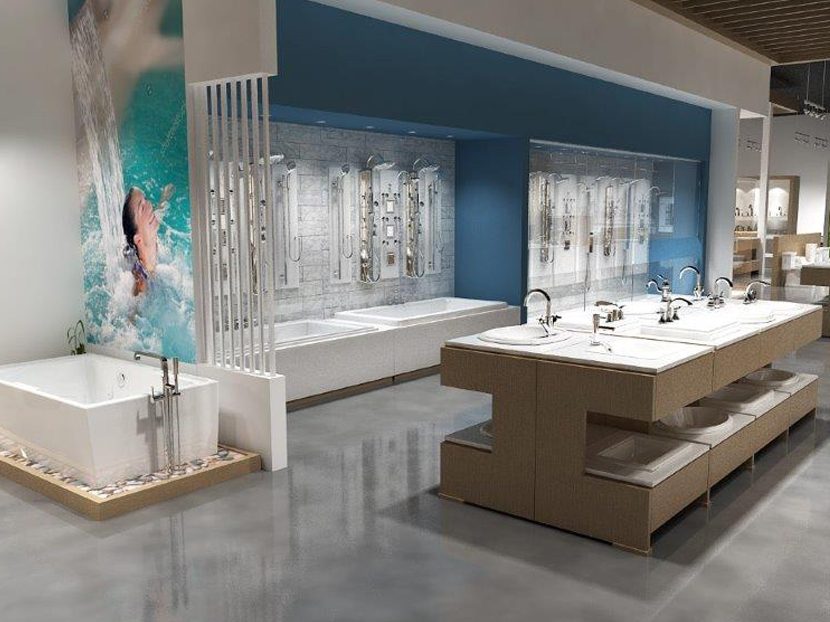10 Ways to Showcase Showroom Products
Visual merchandising uses floor plans, lighting, color and technology to create an inviting environment for customers.

At the center of any showroom are the products. How those products are displayed and arranged has an enormous impact on the customer from the moment she sets eyes on the store. Visual merchandising is a retail practice that has changed drastically in the past few years as technology has made its way into the brick-and-mortar world.
The main components of visual merchandising are floor plans and three-dimensional displays meant to encourage sales, but lighting, color, technology and style are central elements in creating a retail environment that attracts and sells.
A variety of merchandising techniques can be applied in a decorative plumbing showroom. Many of the top showrooms borrow techniques from the design and retail clothing worlds to build impressive spaces that show off the top-of-the-line products they’re selling.
Here are 10 ways to make your showroom better organized, more attractive and easier for customers to navigate.
1. Make the most of your space. From the front door to the back corner, every inch of the showroom has a role to play. A proper layout (or floor plan) organizes the space, shows off the merchandise and guides customers through the showroom.
The most important thing is to ensure your customers do not miss a single product. By leading people through the store on an optimized sales path, customers get a chance to see every tub, sink, faucet and accessory while still having an enjoyable shopping experience.
Use all your space to its advantage. That can mean keeping a portion of the square footage open and airy. Customers walking into a showroom do not want to feel overwhelmed or bombarded by products. Some showrooms even keep the first 20 feet of the store clear so customers have a moment to take in the whole space. Consider using some of those free spaces (no products or selling!) to entice clients to relax and feel at home; some showrooms offerdrinks or snacks to complete the experience.
2. Keep display fixtures consistent. The relationship between consumer and product is different in a kitchen and bath showroom. Overall, showroom merchandising does not encourage grab-and-go shopping. While you want to showcase products in a simple and organized way, you also need to encourage customers to stop and engage with the merchandise.
Using a mix of vendor-supplied displays, mismatched shelving and outdated case goods don’t send the right message, especially if you’re selling high-end products. The right display fixtures made with high-quality materials do even more than make merchandise look good — it makes it look more expensive. There is no reason not to mix materials such as wood, metal and tile as long as they are all top quality and work together.
Even if you include branded manufacturers’ displays in your showroom, the right showroom design incorporates display fixtures into the overall look.
Keep in mind that trends and product lines change; your fixtures have to adapt to these changes. Moveable display fixtures are a good idea if you want to refresh the space according to trends or seasons.
3. Cross-merchandising. By presenting customers with a mix of products in one display, you make it easier for them to visualize how the products work together. With this practice, you can offer the whole solution. Grouping a sink, toilet, vanity and hardware options together allow customers to imagine how the products will look in their homes. Putting faucets near sinks helps people select compatible design options.
While this method does bring up space concerns and may stop customers from going through the whole store, it offers the convenience and ease most shoppers are looking for.
4. Vertical merchandising. Perfect for hardware, faucets and accessories, vertical merchandising keeps popular products at eye-level (where customers tend to focus) and lets them stay in one place to take in all you have to offer in the product category. Properly built vertical displays also keep products organized and offer the ability to group different brands by color, size, finish and price.
The drawback to vertical merchandising is brand impact can be diluted and it is difficult to promote high-profit product lines exclusively at eye-level.
5. Horizontal merchandising. By keeping all products at eye-level, you ensure that the natural tendency of the customer gaze is satisfied; everything is shown off in the right visual space. As an example, placing faucets in a horizontal arrangement (instead of vertically), lets people try the product out and see it from a natural point-of-view. After all, they won’t be placing their new sink and faucet into the kitchen wall!
While horizontal merchandising means customers have to move from side to side to see all the products, it is a way to encourage flow throughout the showroom. This method does not present the same drawbacks it does in most retail environments.
The best bet for a kitchen and bath showroom is to offer a mix of visual displays, including vertical, horizontal and cross-merchandising.
6. Engage the senses. One of the main roles of a decorative plumbing showroom in the age of digital retail is to give people a place to interact with products. Not only does it give the customer a chance to feel how something works, she can test out the quality. It can be difficult to get a sense of certain finishes when you’re looking online, so a showroom gives people the opportunity to see and feel the difference between brass, gold, silver and matte finishes, for example.
Working faucet displays have become popular, especially with so many options on the market. The same goes for other plumbing products and accessories; customers appreciate being able to touch and experience the products they are thinking of buying. They wouldn’t have come into the showroom otherwise!
7. Set the mood with lighting. Lighting can make all the difference. It sets the mood, tells the story of your brand, highlights the best products and encourages purchases. A mix of natural light and good interior lighting are key, although showrooms without large windows or skylights can get creative with lighting design. You can have the same lighting throughout the showroom or change it up.
It can be as simple as putting a spotlight on a best-selling product or as subtle as backlighting mirror displays. Bright lights promote positivity and allow people to see details, which is a plus in areas selling flooring, cabinets and kitchen products. Bathroom items can be lit more dramatically, with dim areas incorporated into the lighting design to make highlighted areas pop.
Colored lighting is another interesting option but is usually used for colorful packaging. High-end showrooms in Europe have incorporated colorful backlights into their wall paneling, making for an impressive statement.
Light creates rhythm and movement. It draws people in. Top lighting designers encourage retail spaces to make sure the back of the store is lit so the space feels inviting. For retail showrooms that frequently move display fixtures, it is better to have a lighting scheme rather than spotlights.
8. Digital tools. Most clients are coming into the showroom with their phones anyway, so why not take control and provide tablets? Showing off merchandise digitally lets you present all the options while keeping clutter off the sales floor; it also helps people see important technical information such as dimensions and finish options.
Tablets can deliver information about promotions, show demo videos and let customers read product reviews. They are also a great point-of-sale tool for sales associates. How about putting some design software on an iPad so clients can start the project right away?
Virtual reality is another trend entering the showroom. VR glasses allow customers to visualize a new kitchen or bathroom, which really gets them in the right state of mind during their showroom visit.
9. Style and color. Industrial, contemporary, coastal, rustic — the style of your showroom will likely be determined by your local market. The most important thing is to keep it simple. Keep distractions to a minimum; avoid flashy decorations and signage. The product has to stand out in today’s showrooms.
Displays can have a modern feel with clean lines and neutral colors or have a classic wood finish in soft greys and browns. Some showrooms go high-contrast while others choose to keep to a monochromatic scheme.
Choosing to use color in a showroom is an option, though most often it is restricted to vignettes or mini-suites. Color has a lot of impact on consumers. It can attract them to certain areas, guide them through the space and, depending on the color, set a certain mood (blues and greens are calming, warmer colors are more exciting).
In terms of merchandise placement, darker items should start on the left and get lighter as you move right or use darker colors on the bottom with lighter colors on top. In the winter, people prefer darker colors; in the summer, lighter colors. Switching the arrangement according to the seasons can have a positive impact on your customers.
No matter which style you choose, make sure the merchandise is the star.
10. Vignettes/mini-suites. There is no better tool in a showroom than a vignette or mini-suite. It allows customers to see exactly how the products look in a home setting. The psychology is simple. If a customer can imagine an item in her life, she is more likely to buy it. Products on a shelf in a display are harder to imagine in a real-world setting, which is why showroom vignettes are so important.
Vignettes also allow for a bit of color, which can break up a too-neutral space. They add visual interest while sparking customer’s imaginations and highlighting the products.
While vignettes are most commonly seen in window displays, kitchen and bath showrooms can use them throughout the space as large-scale merchandising focal points. Mini-bathrooms with a matching toilet and sink are one option; include the bathtub to complete the picture. For kitchens, showcasing a trendy item such as a farmhouse sink with a stunning faucet and some cabinetry is a nice vignette idea.
Visual merchandising in the luxury product world allows for design that fully immerses the customer in the experience. Going far beyond display fixtures and branded environments, a truly stunning showroom creates an ambiance that draws people in.





